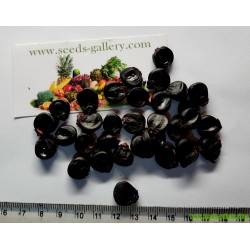- -15%

Peruból származó fajta









Purple corn, a variety of Zea mays, is an Andean crop from low valleys locally called maiz Morado. Purple corn can be found mostly in Peru, where it is cultivated on the coast, as well as in lands almost ten thousand feet high.
Purple corn, a variety of Zea mays, is an Andean crop from low valleys locally called maiz Morado. Purple corn can be found mostly in Peru, where it is cultivated on the coast, as well as in lands almost ten thousand feet high. There are different varieties of purple corn, and all of them originated from an ancestral line called “Kculli”, still cultivated in Peru. The Kculli line is very old, and ancient objects in the shape of these particular ears of corn have been found in archeological sites at least 2,500 years old in places on the central coast, as well as among the ceramics of the “Mochica” culture.
The kernels of purple corn are soaked in hot water by people of the Andes to yield a deep purple color for foods and beverages, a practice now recognized for its industrial uses as a colorant. Common in Bolivia, Ecuador, and Peru, purple corn is used in chicha Morada, a drink made by boiling ground purple corn kernels with pineapple, cinnamon, clove, and sugar, and in mazamorra, a type of pudding. One of the most popular purple corn food uses is the "Api", a smoothie served hot and sometimes called "Inca's dessert".
Purple corn contains substantial amounts of phenolics and anthocyanins, among other phytochemicals. Its main colorant is cianidin-3-b-glucosa. People of the Andes make a refreshing drink from purple corn called "chicha Morada" which is now recognized as a nutritive powerhouse due to its phenolic content. Phenolics are known to have many bioactive and functional properties. Research shows that crops with the highest total phenolic and anthocyanin content also have the highest antioxidant activity.
Anthocyaninins are a type of complex flavonoid that produce blue, purple or red colors.
Purple Corn has a higher antioxidant capacity and antiradical kinetics than blueberries and higher or similar anthocyanin and phenolic contents.
Adatlap
 Reviews (0)
Reviews (0)